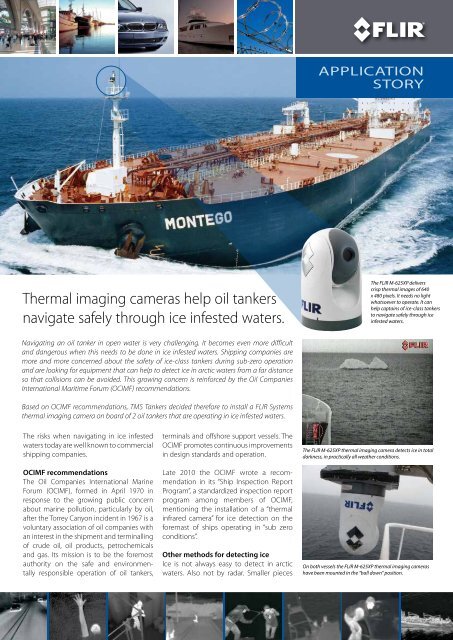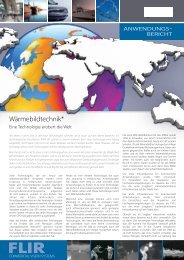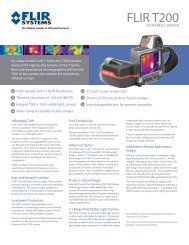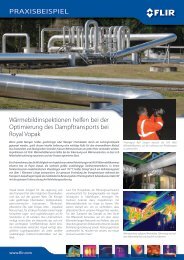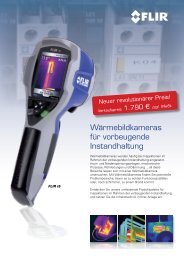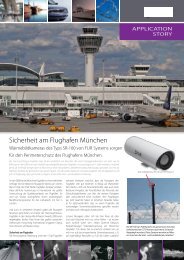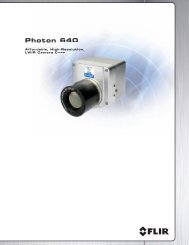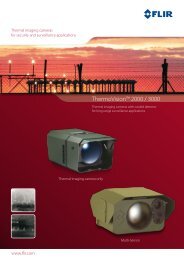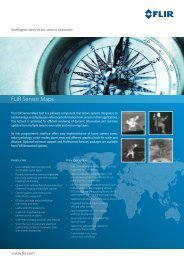Download Application Story - Flir Systems
Download Application Story - Flir Systems
Download Application Story - Flir Systems
Create successful ePaper yourself
Turn your PDF publications into a flip-book with our unique Google optimized e-Paper software.
Thermal imaging cameras help oil tankers<br />
navigate safely through ice infested waters.<br />
Navigating an oil tanker in open water is very challenging. It becomes even more difficult<br />
and dangerous when this needs to be done in ice infested waters. Shipping companies are<br />
more and more concerned about the safety of ice-class tankers during sub-zero operation<br />
and are looking for equipment that can help to detect ice in arctic waters from a far distance<br />
so that collisions can be avoided. This growing concern is reinforced by the Oil Companies<br />
International Maritime Forum (OCIMF) recommendations.<br />
Based on OCIMF recommendations, TMS Tankers decided therefore to install a FLIR <strong>Systems</strong><br />
thermal imaging camera on board of 2 oil tankers that are operating in ice infested waters.<br />
The risks when navigating in ice infested<br />
waters today are well known to commercial<br />
shipping companies.<br />
OCIMF recommendations<br />
The Oil Companies International Marine<br />
Forum (OCIMF), formed in April 1970 in<br />
response to the growing public concern<br />
about marine pollution, particularly by oil,<br />
after the Torrey Canyon incident in 1967 is a<br />
voluntary association of oil companies with<br />
an interest in the shipment and terminalling<br />
of crude oil, oil products, petrochemicals<br />
and gas. Its mission is to be the foremost<br />
authority on the safe and environmentally<br />
responsible operation of oil tankers,<br />
terminals and offshore support vessels. The<br />
OCIMF promotes continuous improvements<br />
in design standards and operation.<br />
Late 2010 the OCIMF wrote a recommendation<br />
in its “Ship Inspection Report<br />
Program”, a standardized inspection report<br />
program among members of OCIMF,<br />
mentioning the installation of a “thermal<br />
infrared camera” for ice detection on the<br />
foremast of ships operating in “sub zero<br />
conditions”.<br />
Other methods for detecting ice<br />
Ice is not always easy to detect in arctic<br />
waters. Also not by radar. Smaller pieces<br />
ApplicAtion<br />
<strong>Story</strong><br />
The FLIR M-625XP delivers<br />
crisp thermal images of 640<br />
x 480 pixels. It needs no light<br />
whatsoever to operate. It can<br />
help captains of ice-class tankers<br />
to navigate safely through ice<br />
infested waters.<br />
The FLIR M-625XP thermal imaging camera detects ice in total<br />
darkness, in practically all weather conditions.<br />
On both vessels the FLIR M-625XP thermal imaging cameras<br />
have been mounted in the “ball down” position.
ApplicAtion<br />
<strong>Story</strong><br />
Ice is clearly visible on a thermal image. A thermal image can<br />
help the captain to navigate safely in arctic waters.<br />
are even harder to detect by radar. This is<br />
particularly true in heavy sea conditions<br />
where the radar returns from ice floes may<br />
be lost in the socalled 'sea clutter', which<br />
means that the waves show up on the radar<br />
image, making it difficult to distinguish<br />
between ice and the waves.<br />
During the daylight hours the inability of<br />
radar to detect ice in certain conditions<br />
can be compensated by visual inspection.<br />
In the long polar nights this task becomes<br />
very difficult due to the lack of light and<br />
even during those scarce hours of daylight<br />
the visibility might be restricted by fog or<br />
snow. In the nighttime the combination<br />
of darkness and fog or snow can limit the<br />
capability of regular eyesight to detect ice<br />
hazards even further. The searchlight only<br />
illuminates objects in the narrow path of its<br />
light beam.<br />
A thermal imaging camera presents a much<br />
wider view, resulting in better situational<br />
awareness.<br />
TMS Tankers<br />
TMS Tankers is part of Cardiff Marine<br />
Inc. and has established a reputation in<br />
the international shipping industry for<br />
operating and maintaining a fleet with<br />
high standards of performance, reliability<br />
and safety. It manages a fleet in excess of<br />
6 million deadweight and is one of the<br />
largest Greek based tanker operators.<br />
Based on the recommendations of the<br />
OCIMF, TMS Tankers, decided to equip<br />
two of its vessels that are operating in ice<br />
infested waters, with a thermal imaging<br />
camera.<br />
Prime Ltd., a FLIR distribution partner that<br />
operates within the Greek territory, supplied<br />
TMS Tankers with two FLIR M625XP thermal<br />
imaging cameras.<br />
The thermal images from the FLIR M-625XP are displayed on<br />
a screen integrated on the bridge.<br />
FLIR thermal imaging cameras<br />
TMS Tankers chose for the FLIR M625XP. It is<br />
equipped with an uncooled, maintenance<br />
free, Vanadium Oxide (VOx) detector that<br />
produces crisp thermal images of 640 x 480<br />
pixels on which the smallest of details can<br />
be seen. It needs no light whatsoever to<br />
produce crisp images.<br />
Image quality was an important but<br />
not the only criterion in the purchasing<br />
process. TMS Tankers needed to be sure<br />
that the thermal imaging cameras would<br />
be operating in harsh arctic conditions. The<br />
FLIR M625XP operates between 25°C and<br />
+55°C. It is also equipped with a heating<br />
systems that avoids ice to grow on the<br />
lens. It delivers a sharp, contrasted thermal<br />
image even in arctic conditions.<br />
Seeing as far as possible to increase<br />
situational awareness<br />
The FLIR M625XP thermal imaging<br />
cameras were installed on the bow of the<br />
mast of the oil tankers as recommended<br />
by OCIMF. This is the highest point where<br />
also the navigational lights are installed.<br />
Installed in this high position, the FLIR<br />
M625XP can overlook a large part of the<br />
ocean in front and beside the vessels.<br />
In both cases, the thermal images that<br />
are generated by the FLIR M625XP can<br />
be seen on a LCD display that is installed<br />
on the bridge of the tanker. The thermal<br />
images on the screen immediately show<br />
the captain and crew if and where there is<br />
ice so that they can more safely navigate<br />
through the ice fields.<br />
The intuitive Joystick Control Unit (JCU)<br />
has been integrated in the bridge. The JCU<br />
allows for easy access to all the features<br />
that are integrated in the FLIR M625XP.<br />
It allows for panning the camera 360°<br />
continuously and for tilting it.<br />
Easy installation<br />
On both vessels the FLIR M625XP thermal<br />
imaging cameras have been mounted in<br />
the “ball down” position.<br />
The FLIR M625XP thermal imaging cameras<br />
are very easy to install. The TMS technicians<br />
supplied the cameras with power coming<br />
from the foremast electricity switchboard.<br />
For running video cable from the camera to<br />
the LCD on the bridge they took advantage<br />
of existing cable ducts. The Ethernet cable,<br />
that needs to be connected to the JCU of<br />
the FLIR M625XP cameras, was also run<br />
though these same cable ducts. No extra<br />
power is needed for the JCU since this<br />
power is supplied by the FLIR M625XP itself<br />
through Power over Ethernet (PoE).<br />
Thanks to 2 FLIR M625XP thermal imaging<br />
cameras TMS Tankers vessels will be navigating<br />
even more safe through arctic waters.<br />
Customer<br />
Furnished<br />
Display<br />
Video Out<br />
Power In<br />
Ethernet<br />
MENU USER<br />
COLOR<br />
SCENE HOME<br />
91 mm<br />
Joystick Control Unit<br />
141 mm<br />
178 mm<br />
For more information about thermal imaging<br />
cameras or about this application,<br />
please contact:<br />
FLIR Commercial <strong>Systems</strong> AB<br />
Luxemburgstraat 2<br />
2321 Meer<br />
Belgium<br />
Tel. : +32 (0) 3665 5100<br />
Fax : +32 (0) 3303 5624<br />
e-mail: flir@flir.com<br />
284 mm<br />
AS_0912_0055_EN


